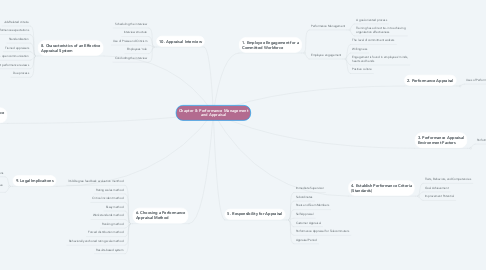Chapter 8: Performance Management and Appraisal
par Thơ Trần


1. 6. Choosing a Performance Appraisal Method
1.1. 360-Degree feedback evaluation menthod
1.2. Rating scales method
1.3. Critical incident method
1.4. Essay method
1.5. Work standards method
1.6. Ranking method
1.7. Forced distribution method
1.8. Behaviorally anchored rating scale method
1.9. Results-based system
2. 7. Problems in Performance Appraisal
2.1. Appraiser discomfort
2.2. Lack of objectivity
2.3. Halo/horn error
2.4. Leniency/Strictness
2.5. Central tendency
2.6. Recent behavior bias
2.7. Personal bias (Stereotyping)
2.8. Manupulating the evaluation
2.9. Employee Anxiety
3. 8. Characteristics of an Effective Appraisal System
3.1. Job-Related criteria
3.2. Performance expectations
3.3. Standardization
3.4. Trained appraisers
3.5. Continuous open communication
3.6. Conduct performance reviews
3.7. Due process
4. 9. Legal Implicaitons
4.1. Result from negative evaluations
4.2. Mistakes in appraising performance and decisions based on invalid results can have serious repercussions
5. 10. Appraisal Interview
5.1. Scheduling the interview
5.2. Interview structure
5.3. Use of Praise and Criticism
5.4. Employees' role
5.5. Concluding the interview
6. 1. Employee Engagement for a Committed Workforce
6.1. Performance Management
6.1.1. A goal-oriented process
6.1.2. Training has a direct tie-in to achieving organization effectiveness
6.2. Employee engagement
6.2.1. The level of commitment workers
6.2.2. Willingness
6.2.3. Engagement is found in employees' minds, hearts and hands
6.2.4. Positive culture
7. 2. Performance Appraisal
7.1. Uses of Performance Appraisal
7.1.1. Human Resource Planning
7.1.2. Recruiment and Selection
7.1.3. Training and Development
7.1.4. Career Planning and Development
7.1.5. Compensation Programs
7.1.6. Internal Employee Relations
7.1.7. Assessment of Employee Potential
8. 3. Performance Appraisal Environment Factors
8.1. Performance Appraisal Process
8.1.1. Identify specific performance appraisal goals -> Establish performance criteria and communicate them to employees -> Examine work performed -> Appraise performance -> Discuss appraisal with employee
